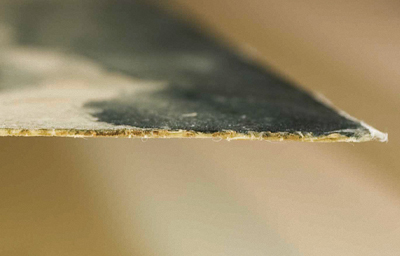Detail: Adhesive residue
When painting in watercolor, brushing the washes onto a loose sheet will cause the paper to distort. To prevent papers from distorting, artists traditionally stretched and strained their watercolor papers prior to painting. The process involved dampening the sheet and then restraining the edges while drying, either by gluing or tacking them to a board.
A drawing block was especially convenient for outdoor use, as it would have provided a restrained sheet with rigid support, freeing Homer from the time-consuming process of pre-stretching his paper and mounting it to a board prior to painting. The thick, well-sized papers, securely bound on all sides, allowed the artist to work quickly with wet washes such as the dilute blue used in the sky. Many of Homer’s watercolors bear evidence of having come from a solid drawing block. Often, a thin brown line of adhesive residue is found along the edge of a sheet, as is the case with Sunshine and Shadow.
Detail, upper-right edge of Sunshine and Shadow, showing clear yellow adhesive residue from the solid drawing block.

